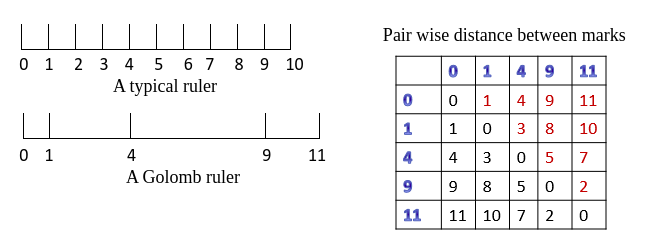What are Golomb Rulers?
Imagine a normal ruler, and make a series of notches on it at a few of the numbered points. Now, calculate the pairwise distance (meaning, if you have 0 1 4 9 11, you need the difference between 0 and 1, 0 and 4, 0 and 9, 0 and 11; the difference between 1 and 4, 1 and 9...) for all points.
If every difference you got is unique- that's a Golomb Ruler!

Variants
These Golomb Patterns (or, non-patterns) don't just exist as flat lines. They exist in rectangular grids, honeycomb grids, circular coordinates... There are even specific forms, such as the Costas array (proposed by mathematician John Costas in the 1960s), a rectangular grid with exactly one mark in each row and column.
Applications
For such a specific mathematical idea, these patterns have applications in a wide range of fields. Such as:
- File compression (Kautz, 1954)
- Cryptography
- Sensor placement in X-ray Crystallography
- Radio-frequency allocation (Babock 1953)
- Circuit layout
- Antenna design for Radar missions
- Sonar Applications
- Linear telescope arrays in radio astronomy
That last item is one we want to highlight. Getting better pictures of the cosmos is a noble, but difficult, endeavor. We can build bigger telescopes- but just to get a resolution similar to the Hubble from the ground, you'd need a kilometer wide receiver. Or, we can establish multiple small receivers, and create a distributed telescope. In 2019, a team of scientists used this idea at a whole new scale to capture the first ever image of a black hole.
For a distributed system to work, each aperture would have to be positioned to capture a non-redundant portion of all the data.
These non-redundant configurations map near-perfectly to the mathematical concept of a Golomb Pattern. And that is where you- our citizen scientists- come in. Computing these patterns by brute force is exponentially difficult, but people have a lot of success finding them by trial-and-error. You can play the game and contribute to the known repository of Golomb Patterns. Your contribution could help scientists understand our universe in a new way.
But why Citizen Science?
Why couldn't we just pay to have a super-computer crunch the numbers on the best Golomb patterns? Because the problem of constructing Golomb-related patterns is speculated to be NP-hard (see some of the papers below for further reading on that), meaning it is difficult and expensive for a computer to generate new patterns. But, it's easy to check if a pattern is a valid Golomb patterns, and people (citizen scientists like you) are great at coming up with them!
Further reading
- A paper on computer-search for optimum Golomb Rectangles
- Simon Golomb et al on the basics of Costas Arrays
- Another paper from Simon G. on Costas Arrays
- A good MATLAB toolbox to play with Costas Arrays
- A paper on the computational complexity of constructing new Golomb rulers
- A paper reviewing the known methods of mathematically constructing Golomb rulers